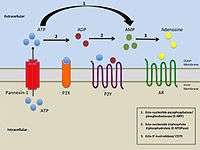Pannexin
| Part of a series on |
| Purinergic signalling |
|---|
 Simplified illustration of extracellular purinergic signalling |
| Concepts |
| Membrane transporters |
| pannexin 1 | |
|---|---|
| Identifiers | |
| Symbol | PANX1 |
| Entrez | 24145 |
| HUGO | 8599 |
| OMIM | 608420 |
| RefSeq | NM_015368 |
| UniProt | Q96RD7 |
| Other data | |
| Locus | Chr. 11 q14-q21 |
| pannexin 2 | |
|---|---|
| Identifiers | |
| Symbol | PANX2 |
| Entrez | 56666 |
| HUGO | 8600 |
| OMIM | 608421 |
| RefSeq | NM_052839 |
| UniProt | Q96RD6 |
| Other data | |
| Locus | Chr. 22 q13 |
| pannexin 3 | |
|---|---|
| Identifiers | |
| Symbol | PANX3 |
| Entrez | 116337 |
| HUGO | 20573 |
| OMIM | 608422 |
| RefSeq | NM_052959 |
| UniProt | Q96QZ0 |
| Other data | |
| Locus | Chr. 11 q24.2 |
Pannexins (from Greek 'παν' — all, and from Latin 'nexus' — connection) are a family of vertebrate proteins identified by their homology to the invertebrate innexins.[1] While innexins are responsible for forming gap junctions in invertebrates, the pannexins have been shown to predominantly exist as large transmembrane channels connecting the intracellular and extracellular space, allowing the passage of ions and small molecules between these compartments (such as ATP and sulforhodamine B).
Three pannexins have been described in Chordates: Panx1, Panx2 and Panx3.[2]
Function
Pannexin 1 has been shown to be involved in early stages of innate immunity through an interaction with the P2X7 purinergic receptor. Activation of the pannexin channel through binding of ATP to P2X7 receptor leads to the release of interleukin-1β.[3]
Hypothetical roles of pannexins in the nervous system include participating in sensory processing, synchronization between hippocampus and cortex, hippocampal plasticity, and propagation of calcium waves. Calcium waves are supported by glial cells, which help maintain and modulate neuronal metabolism. According to one of the hypotheses, pannexins also may participate in pathological reactions, including the neural damage after ischemia and subsequent cell death.[4]
Pannexin 1 channels are pathways for release of ATP from cells.[5]
Relationship to connexins
Intercellular gap junctions in vertebrates, including humans, are formed by the connexin family of proteins.[6] Structurally, pannexins and connexins are very similar, consisting of 4 transmembrane domains, 2 extracellular and 1 intracellular loop, along with intracellular N- and C-terminal tails. Despite this shared topology, the protein families do not share enough sequence similarity to confidently infer common ancestry.
Clinical significance
Pannexins may be involved in the process of tumor development. Particularly, PANX2 expression levels predict post diagnosis survival for patients with glial tumors.
Probenecid, a well-established drug for the treatment of gout, allows for discrimination between channels formed by connexins and pannexins. Probenecid did not affect channels formed by connexins.[7]
References
- ↑ Panchin Y, Kelmanson I, Matz M, Lukyanov K, Usman N, Lukyanov S (2000). "A ubiquitous family of putative gap junction molecules". Curr. Biol. 10 (13): R473–4. doi:10.1016/S0960-9822(00)00576-5. PMID 10898987.
- ↑ Litvin O, Tiunova A, Connell-Alberts Y, Panchin Y, Baranova A (2006). "What is hidden in the pannexin treasure trove: the sneak peek and the guesswork". J. Cell. Mol. Med. 10 (3): 613–34. doi:10.1111/j.1582-4934.2006.tb00424.x. PMID 16989724.
- ↑ Pelegrin P, Surprenant A (November 2006). "Pannexin-1 mediates large pore formation and interleukin-1β release by the ATP-gated P2X7 receptor". EMBO J. 25 (21): 5071–82. doi:10.1038/sj.emboj.7601378. PMC 1630421
 . PMID 17036048.
. PMID 17036048. - ↑ Bargiotas, P; Krenz, A; Hormuzdi, SG; Ridder, DA; Herb, A; Barakat, W; Penuela, S; von Engelhardt, J; Monyer, H; Schwaninger, M (Dec 2011). "Pannexins in ischemia-induced neurodegeneration". Proc Natl Acad Sci U S A. 108 (51): 20772–7. doi:10.1073/pnas.1018262108. PMID 22147915.
- ↑ Bao L, Locovei S, Dahl G (August 2004). "Pannexin membrane channels are mechanosensitive conduits for ATP". FEBS Lett. 572 (1-3): 65–8. doi:10.1016/j.febslet.2004.07.009. PMID 15304325.
- ↑ Dahl G, Locovei S (July 2006). "Pannexin: to gap or not to gap, is that a question?". IUBMB Life. 58 (7): 409–19. doi:10.1080/15216540600794526. PMID 16801216.
- ↑ Silverman W, Locovei S, Dahl G (September 2008). "Probenecid, a gout remedy, inhibits pannexin 1 channels". Am. J. Physiol., Cell Physiol. 295 (3): C761–7. doi:10.1152/ajpcell.00227.2008. PMC 2544448
 . PMID 18596212.
. PMID 18596212.
Further reading
- Andrew L Harris & Darren Locke (2009). Connexins, A Guide. New York: Springer. p. 574. ISBN 978-1-934115-46-6.